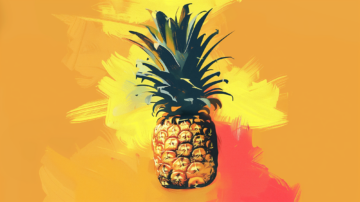Tony Morley at The Up Wing:
 In 1667 John Rose, the royal gardener, took a knee at the foot of Charles II, the King of England, and presented him with a pineapple. This wasn’t the $3.00 discount pineapple from your local grocer, but rather the single most expensive fruit in the Western world. Christopher Columbus was perhaps the first Westerner to encounter the pineapple in 1493 on the island of Guadeloupe, a small island amongst a grouping of islands that includes Puerto Rico, Dominica, St Lucia, and Barbados. Columbus called the fruit “piña de Indes,” ‘pine of the Indians’ and with considerable difficulty, managed to bring a small quantity of unspoiled pineapple back to Europe. The pineapple was a fruit that could only grow within tropical regions and was astonishingly difficult to transport, frequently spoiling on the journey across the Atlantic. While it isn’t clear when the first pineapples arrived in England, what is clear, is that the ones that managed the journey without spoiling commanded astonishingly high prices, to the tune of thousands of pounds. At the dawn of the Industrial Revolution, the pineapple could be imported from the New World, often with high levels of spoilage losses, or grown in one of less than a handful of royal greenhouses, an option which was no less expensive than imported pineapple. The cost of domestic pineapple in England was so high as to make the fruit essentially too valuable to eat. Pineapples may well have been eaten by the King, but lesser royalty had used the pineapple as a luxury ornament, the ultimate pre-industrial flex. Guests would gather around, not to eat the pineapple, but simply to stare at its manifest symbolism of wealth, luxury, rarity, and power.
In 1667 John Rose, the royal gardener, took a knee at the foot of Charles II, the King of England, and presented him with a pineapple. This wasn’t the $3.00 discount pineapple from your local grocer, but rather the single most expensive fruit in the Western world. Christopher Columbus was perhaps the first Westerner to encounter the pineapple in 1493 on the island of Guadeloupe, a small island amongst a grouping of islands that includes Puerto Rico, Dominica, St Lucia, and Barbados. Columbus called the fruit “piña de Indes,” ‘pine of the Indians’ and with considerable difficulty, managed to bring a small quantity of unspoiled pineapple back to Europe. The pineapple was a fruit that could only grow within tropical regions and was astonishingly difficult to transport, frequently spoiling on the journey across the Atlantic. While it isn’t clear when the first pineapples arrived in England, what is clear, is that the ones that managed the journey without spoiling commanded astonishingly high prices, to the tune of thousands of pounds. At the dawn of the Industrial Revolution, the pineapple could be imported from the New World, often with high levels of spoilage losses, or grown in one of less than a handful of royal greenhouses, an option which was no less expensive than imported pineapple. The cost of domestic pineapple in England was so high as to make the fruit essentially too valuable to eat. Pineapples may well have been eaten by the King, but lesser royalty had used the pineapple as a luxury ornament, the ultimate pre-industrial flex. Guests would gather around, not to eat the pineapple, but simply to stare at its manifest symbolism of wealth, luxury, rarity, and power.
More here.
Enjoying the content on 3QD? Help keep us going by donating now.
